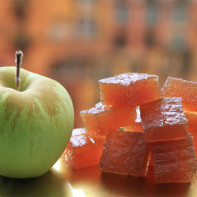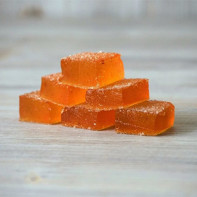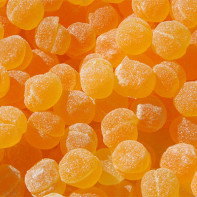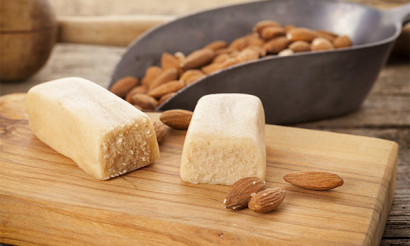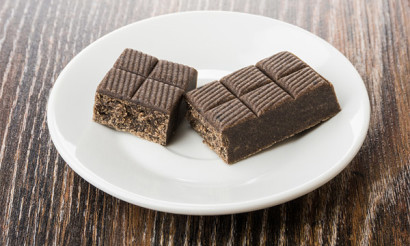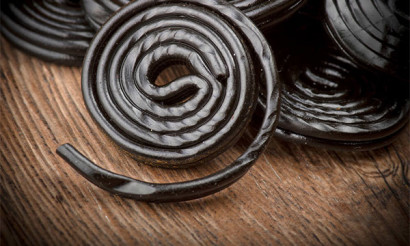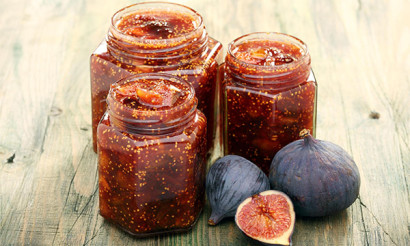Marmalade: useful properties and contraindications
Marmalade is a treat that both adults and children love. The homeland of sugar sweets is the Middle East and Mediterranean countries. It is in these territories that people first became interested in recipes for the preparation of such sweets. After a period of time, marmalade migrated to Europe. For example, in France, cooks used to prepare jam, the consistency of which was so dense that the resulting product was cut into pieces in the form of marmalades. It was the French who gave the product its name, which undoubtedly influenced its enormous popularity. The English are also very fond of marmalade and almost every morning they serve it to the table. In the countries of Eastern Europe, preference is given to the chewy fruit or berry jelly type of dessert.
- What is marmalade and what is it made of
- Types of .
- What is the difference between jelly and marmalade
- How much can be eaten per day marmalade
- Composition and calories
- What is the usefulness of marmalade
- For Women
- For Men
- For Pregnancy
- Breastfeeding
- For children
- Is it possible to eat jelly when losing weight
- What is the healthiest marmalade
- Chewy
- On agar-agar
- On fructose
- Pectin
- Marmalade in medicine
- For Diabetes Mellitus
- For pancreatitis
- For gastritis
- When constipation
- With gout
- For cholecystitis
- Harm and contraindications
- How to choose and store marmalade
- How to make marmalade at home
- Chewy marmalade
- Marmalade with Gelatin
- Is it possible to eat marmalade during the Lent?
- Interesting facts about marmalade
What is marmalade and what is it made of
Marmalade is a sweet that is essentially the juice of fruit, evaporated to a firm but resilient state. At one time, the most popular ingredients used to make this delicacy were fruit and berry fruits, rich in the natural gelling agent pectin. Preferred fruits included quinces and apples, and apricots and currants were also actively used. Tasty vitamin marmalades were spread practically all over Europe, from where they came later to Asia. Marmalade at one time was very popular in Portugal.

But after the English began to conquer the seas, they took over the recipes for making this product from the Portuguese, and they boiled most of the citrus fruit. By the way, that's why candied lemon and orange wedges are considered the traditional type of dessert, still in production today. Later, when people began to know the technology of special gelling agents - gelatin and agar-agar, it was them who began to be used in the process of making fruit and berry juices. Today the most "democratic" varieties are those that include agar-agar, sugar, food coloring and flavorings.
As is probably already clear, a mandatory component of marmalade is a gelling agent. At the same time it can be divided into categories:
- Pectin. It is considered the most useful and safe option. It is extracted from certain types of seaweed or from fruits and berries. This substance has a favorable effect on the work of many organs and body systems.
- Agar-agar. It is a "powerful" gelling substance. It is extracted from lower plants (also from algae). Agar-agar is useful for humans because it is rich in many micronutrients.
To make quality marmalade also need to monitor the naturalness of the fruit juice/mash. In a mass of fruit pulp add a sweet component (sugar or molasses), and then evaporate the liquid from the mixture. The resulting thick mass is mixed with a portion of the gelling agent and dye, and then placed in a specially designated place for solidification.
To make quality sugar sweets, it is necessary to use natural safe dyes, for example, turmeric or elderberry juice. Often manufacturers who are trying to save on the components of the product use weakly concentrated fruit and berry juice or plain water with chemical flavorings. In addition, unnatural dyes are also actively used. The product, of course, comes out cheaper, but it does not carry any benefits. And sometimes even has a negative impact on the human body.
Unnatural marmalade can be quite easily identified during the initial inspection - it will have a "chemical" aroma and a very bright coloring.
Types
Marmalade can be divided into several types:
- Fruit and berry. A natural fruit or berry mass (puree), which contains a lot of pectin, is used for production.
- Jelly-fruit. For the manufacture uses fruit and berry juices (puree), also added jelly-forming substances.
- Jelly. Jelly makers are used for its manufacture, natural juices and purees are not included in its composition.
What is the difference between jelly and marmalade
Jelly is made on the basis of fruit juices and sugar, and is not brought to a high temperature during the cooking process. The fruit involved in the cooking process is slowly brought to the right conditions, in which the muslin cloth is used. Sugar is added to the resulting fruit juice and already brought to a jelly-like state. Jelly is used in the same way as jam, for example, together with toast and buns, but it is not suitable as a base for pies, because it melts very quickly.
Marmalade, unlike jelly, undergoes a cooking process. Fruit and berries are used in its preparation, as well as thickeners. The product is consumed most often at breakfast together with toast, in addition, it is present in the composition of some pudding recipes.
How much marmalade can be eaten per day
In fact, there are no strict restrictions on the consumption of marmalade. The only thing to pay attention to is possible allergies. If it is absent, it is allowed to eat up to 300 grams of candy per day. It is not recommended to wash down marmalade carbonated beverages.
Composition and calories
In 100 grams of product contains:
- Calories - 321 kcal;
- protein - 0.1 g;
- fats - 0 g;
- Carbohydrates - 79.4 g.
The sweet contains gelling agents, pectin, as well as sugar. It is impossible not to mention the food additives included in the chemical composition of the product. In addition, it contains vitamins B2 and PP, as well as minerals such as calcium, phosphorus and iron.
What is the usefulness of marmalade
Fruit and berry dessert helps regulate cholesterol levels and normalizes metabolism. In addition, it improves the functioning of the pancreas and liver, as well as accelerates tissue repair in case of wounds or burns. Agar-agar-based treats are able to suppress appetite, they support the functioning of the liver, have a laxative effect and enrich the body with iodine. If we talk about chewy marmalade, it can be used to alleviate neuroses and strengthen ligaments and cartilage. It can have a calming effect, get rid of bacteria in the mouth, support brain activity and strengthen the immune system.

For women
Women often have to limit themselves to eating sweets, because this type of food can have a negative impact on their body shape. However, this does not apply to marmalade. The treat allows women to enjoy the product, while not affecting their body weight and not creating unpleasant problems with the figure.
Marmalade is the lowest-calorie confectionery product. The greatest benefit can come from the fruit and berry variety of this product. Other types, although slightly inferior, still have a lot of useful properties.
The product is also valuable because it contains very few carbohydrates and no fat at all. Therefore, even women who sit on strict diets and watch their figure, are allowed to indulge themselves with small portions of this delicacy.
Marmalade helps the female body to get rid of toxins, supports the structure and quality of the hair, skin and nails, shows its effectiveness as an anti-stress agent and normalizes the processes associated with digestion. But it is also important not to forget the potential harm of the product. Since various chemical additives are often added to marmalade, it can cause allergic reactions. To avoid unpleasant consequences when choosing a delicacy, it is necessary to study its composition.
For men
Pectin contained in the product contributes to a more effective removal of "bad" cholesterol from the body, as well as prevents the final coarsening of men's skin. In addition, a recent study showed that this product helps protect the body from the growth of cancer cells. Therefore, men who have a high chance of developing cancer are recommended to include marmalade in their diet. It is necessary to read the composition of the purchased product very carefully, because sometimes manufacturers in the manufacture use instead of a useful substance - pectin - harmful preservatives that not only will not help reduce the risk of developing various diseases, but on the contrary - will aggravate the current condition.
In pregnancy
It is allowed to eat marmalade during pregnancy, but you need to take into account some features of this product. Of course, you should make sure that it itself is of high quality, it is very important during pregnancy. In the manufacture of the sweet, various jelly formers are used. Almost all of them are harmless to the health of women in pregnancy. For example, pectin helps to support digestion and eliminate toxins from the body. Gelatin has a beneficial effect on the skin, hair and nails, which tend to deteriorate at this time.
If marmalade is based on agar-agar, it activates the functioning of the liver. Therefore, women in the position can eat the treat, but it is worth taking into account such moments as the size of portions and the period of pregnancy. In the first and third trimesters the use of this product should be limited. The daily rate is considered a maximum of 50 g, weekly - 200 g.
When breastfeeding
When breastfeeding, marmalade is also allowed. Experts recommend consuming this treat for young mothers, as it helps to alleviate postpartum depression. Breastfeeding women can safely eat marmalade, as it has no fat at all. But it is not recommended to overdo it with portions.
The product should be introduced in stages, so that you can immediately understand whether it suits the child or not. If, after using a treat a child began to manifest allergic reactions, such as colic, then it should be abandoned. The sweet dessert can give nursing women more positive emotions and improve the overall mood, which is simply necessary during lactation. Marmalade, as a rule, is enriched with berry and fruit juices, so the resulting product gets a lot of vitamins that a woman needs during the recovery period after pregnancy.
For kids
Classic marmalade can be included in a child's diet from 2 years of age, if we are talking about chewy - not before 3 years. A small portion of the treat is usually offered to the child after a regular meal as a dessert. Doctors do not recommend giving marmalade, as well as any other sweet products, to kids under 1 year of age. After the child is a year old, he can begin to be introduced to natural fruits and berries. If parents want to expand children's diet with sweets, then a small amount is allowed to give marmalade, marshmallow or marshmallow. In this case, you need to make sure that the products were of good quality. The best option would be to cook marmalade at home.
It is not recommended to give a child a treat before the main meal, because it will affect appetite.
Is it possible to eat marmalade when losing weight
Those who have ever tried to stick to any diet know that it is not that easy. If there are no sweets at all in the diet, the overall condition can be simply unbearable. At the moment when the body begins to feel hunger due to the restrictions that the diet requires, its appetite grows even greater than it was before (especially if we're talking about sweet products).
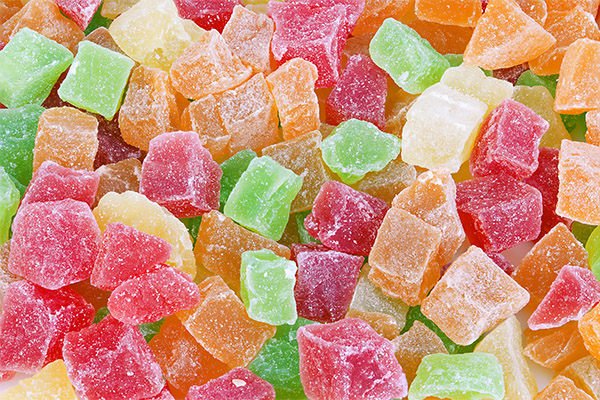
But not all sweets are forbidden to eat during weight loss. Nutritionists are quite relaxed about some of them, such as marmalade. This treat is not prohibited to eat on a diet, if you do it with the observance of some rules. To begin with, you need to study the composition of the product itself. If its composition contains artificial additives, substitutes and enhancers, then such a product will not just prevent you from shedding extra pounds, but can even harm the body. Therefore, when choosing, make sure that it contains only natural ingredients.
In addition, you should know some rules:
- It is necessary to observe the measure of consumption. If there are no other sweets in the diet menu, then you can consume up to 40 g of sugar candy per day.
- It is better to choose a product, which does not contain an excessive amount of sugar. Some manufacturers sprinkle marmalade with sugar. To protect yourself, it is recommended to remove excess sugar from the product. From this, the marmalade will not become less tasty, while its caloric value will be significantly reduced.
- You should stick to the rule - consume sweets only in the first half of the day. In some cases, you can relax a little and allow yourself a cup of tea with sugar until 16 hours.
It is also worth remembering about the quality and naturalness of the product, both during the diet and after it. Although natural marmalade is a little more expensive, you should still buy it. On a diet, marmalades are eaten in limited quantities, so it won't affect your wallet too much.
What is the healthiest marmalade
Today you can find on sale a large number of different types of marmalade - from bright with an unusual shape to not very attractive frozen. However, to understand the degree of usefulness of the product, it is necessary to evaluate it not by its appearance, but by its composition. Let's figure out which of the main types of marmalade is more useful.
Chewy .
Usually, in order for beautiful chewy marmalade not to stain the hands, they are covered with a grease mixture, which, of course, does not add to its usefulness. In addition, this type of marmalade, unlike the others, contains thickeners, preservatives and dyes. Therefore, sometimes the most rich and appetizing candy can seem rubbery or even make a crunch. This type of marmalade is dangerous because it can damage not only the tooth enamel, but also disrupt the gastrointestinal tract. Even despite its positive aspects, which, of course, it has, still we cannot call this type of treat the most useful.
Agar-agar
Agar-agar, which is used in the manufacture of sweets, is a natural thickener, so marmalade on its basis is not harmful to humans. It helps to eliminate toxins and impurities from the body, and also normalizes the gastrointestinal tract. However, it is worth noting the negative aspects of this delicacy. For example, it is rich in iodine, so for people who suffer from thyroid problems, it will be useful. However, too much iodine in the body can lead to its overabundance, which is not very good.
On fructose.
As a rule, sweet products imply the presence of sugar in them, this also applies to marmalade. However, there is a type of marmalade in which there is no sugar, because it is replaced by fructose. Such a product is excellent for diabetics, as fructose does not provoke a sharp spike in blood glucose levels. However, this treat should also be eaten in moderation, otherwise you can get obesity.
On pectin
Pectin is a natural and harmless thickener. It has a number of useful properties. For example, it has anti-inflammatory and analgesic effects, normalizes metabolism, regulates cholesterol and improves circulation. Caution should be exercised when using it diabetics, ulcers, and women in pregnancy.
Considering all of the above advantages and disadvantages of each type, we can say that it is not possible to identify a clear leader. However, it is worth noting that the least useful is chewy marmalade. Fructose-based treats should be categorized as products for certain groups of people with illnesses or sugar intolerances. And if we talk about marmalades based on pectin and agar-agar, each of the thickeners has its own unique characteristics and properties. Both of these substances can be called useful and safe for humans.
Marmalade in medicine
Marmalade is a treat that is allowed to be consumed in almost all cases, regardless of the state of health. At the same time, it is necessary to follow the composition of the product, because it can vary from species to species and from manufacturer to manufacturer. In addition, depending on the course of the disease may vary and portions.

For Diabetes Mellitus
Marmalade in diabetes is allowed. However, experts insist that you can eat only treats made only with your own hands at home. It is recommended to consume marmalade in the first half of the day, the daily rate - no more than 150 grams. Naturally, the product should not contain sugar, so if you decide to buy marmalade in the store, you need to choose a special kind.
Important: The glycemic index of marmalade is 55 units.
In pancreatitis.
Since modern manufacturers of marmalade in the process of its manufacture save on natural components and use substitutes, the usefulness of the product is reduced. This is especially reflected in people suffering from pancreatitis. Nevertheless, this product is allowed to eat. It is worth noting that you can include it in your diet after 3 months of stable remission. It is not recommended to eat more than one slice of dainty per day. If the condition has been stable for a long time, the portion can be increased to a couple of pieces at a time (up to 4 per day). During an exacerbation of the disease, it is forbidden to include this product in the menu.
With gastritis
With gastritis, marmalade is allowed to use. This product has relatively few calories, so it is excellent as a dessert during the course of the disease. It is worth noting that even the composition of the treat does not play a special role. On pectin, on fructose, with agar-agar or with gelatin - all kinds of marmalade with gastritis can be eaten.
When constipated
Marmalade is among the products that contribute to the normalization of the evacuatory function of the colon. Since this delicacy has a laxative effect, it can and even should be consumed with constipation.
For gout
Marmalade is not a health hazard for gout, so it can also be eaten in this case. However, do not combine this product with chocolate or with such berries as grapes, raspberries, figs and cranberries.
For cholelithiasis
People with chronic cholecystitis are allowed to eat sweets and sweet dishes. In addition to chocolates and marshmallows, marmalade can also be included in the diet. At the same time, in order to avoid negative consequences, it is necessary to observe moderation in consumption. The recommended daily rate of sugar in cholecystitis is considered about 60 g. This is the total daily rate. If, in addition to marmalade, the patient consumes any other products containing sugar, they should also be taken into account. People in old age are allowed to eat up to 50 g of sugar per day.
Harm and contraindications
Marmalade can be harmful to the body, especially if the manufacturers have not taken care of its quality. Only natural products can be useful. If it contains chemicals, substitutes or dyes, you should not eat it, because it is a health risk. Today, much to our regret, on the store shelves a lot of uncertified and simply counterfeit products. In this case, for the quality of marmalade no one is responsible, so after his use may have allergic reactions in the form of redness and rash on the skin.
In addition, some manufacturers replace sugar with sweeteners, which can harm the body. But even if the product turned out to be of high quality, it is necessary to observe the measure of its consumption. Overeating this treat can provoke an upset stomach.
How to choose and store marmalade
When choosing marmalade, the first thing to pay attention to is the appearance of the product. If it is characterized by excessive stickiness and moisture, it is likely that the conditions in which it was stored were not suitable. A quality product should be dry. In shape, the treat should be crisp and undeformed; in consistency, it should be elastic.

When cut, the inside of a quality product is smooth and transparent. The taste of the dessert is slightly sour, in case there is a richly sweet taste, it is a low quality product. The color of the dessert should be homogeneous with transparency. If the color is too faded, it is likely that it contains lutein (a natural dye). If the color of the product is too rich, then it contains unnatural dyes, possibly even dangerous for the body. If you buy marmalade by weight, make sure that the package has the date of manufacture. In addition, it is necessary to carefully study the composition of the product.
For storage, it is recommended to put marmalade in a metal (preferably tin) jar. In addition, the product can be stored in a sealed glass container or in food foil. If you do not have at hand any of these containers, you can use ordinary food film. You simply need to wrap the product in it and place it in the refrigerator, previously placing it in a plate or plastic container. The dainty should be placed in a dark cool place.
The product can retain its characteristics for a long time at a humidity of 75-85% and a temperature of 15 ° C. In this form classic marmalade can keep for about 2 months, chewy - up to 3 months. The product on weight is allowed to store about 2 weeks.
How to make marmalade at home
Chewy marmalade
Ingredients:
- jelly (fruit) - 90 g;
- citric acid - 0,5 tsp;
- gelatin - 4 tbsp;
- water - 130 ml;
- sugar - 2 tbsp.
How to prepare:
- Mix in one bowl jelly with gelatin, sugar and citric acid.
- Pour water into a saucepan, after boiling pour the mixed ingredients into it. Add a little at a time, stirring with a whisk.
- Boil for about 4 minutes. Pour the mass into a container so that it can freeze. When it has cooled down, put it in the fridge.
- After a few hours cut the marmalade into small pieces, and then sprinkle with sugar or powdered sugar.
Marmalade with gelatin

Ingredients:
- berries - 300 g;
- gelatin - 2 tbsp;
- sugar - 100 gr;
- cold water - 8 tbsp.
How to prepare:
- Pour the berries with water (a small amount) and boil for about 5 minutes.
- Then soak the gelatin in cold water.
- Pound the berries in a blender.
- The resulting mass is rubbed through a sieve to remove skins and seeds.
- After getting the juice, send it again to the saucepan and add sugar and gelatin.
- While heating the mass, stir it constantly, but do not bring it to a boil.
- Pour into molds. If you have no molds, gelatin mass can be poured into any container (a layer of about 3 cm). In a freezer marmalade can harden for 2 hours, at room temperature - for 5 hours.
- After solidifying the obtained product roll in sugar. Cut the marmalade into pieces.
Is it possible to eat marmalade during Lent?
It is allowed to eat marmalade in Lent, because it does not contain any prohibited substances.
Interesting facts about marmalade
- The name of the delicacy is translated from the French as "quince jam".
- Due to its sweet taste and nutritional value, marmalade is approved in France as a mandatory element of dry rations.
- The largest marmalade in history was 1.7 m tall and weighed over 600 kg.
«Important: All information on this site is provided for informational purposes only. for informational purposes only. Please consult a health care professional before using any of our recommendations. specialist before applying any of the recommendations. Neither the editors nor the authors shall be liable for any possible harm caused by materials."


